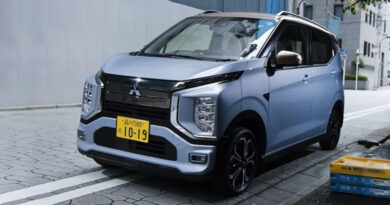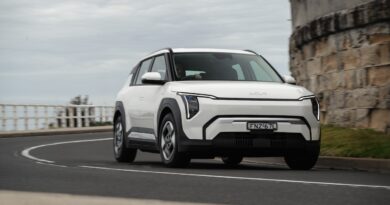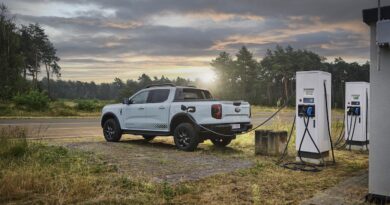2025 Ford Ranger PHEV Review: The best diesel dual cab ute is now plug-in petrol-electric, should BYD Shark 6 and GWM Cannon Alpha be scared?
The Ford Ranger is unchallenged as the best dual cab 4×4 ute going around in Australia today. As a diesel.
But what happens when you swap out the mighty V6 or the bi-turbo four-cylinder for a petrol-electric plug-in hybrid powertrain?
Suddenly there’s a new set of parameters to consider, like EV-only running and how well traditional ute virtues such as payload and towing are retained.
READ MORE: Advantage China? Ford cautious on Ranger PHEV expansion as BYD and GWM plan faster plug-in roll-out
READ MORE: Look out BYD Shark 6 and GWM Cannon Alpha! Ford Ranger PHEV pricing and specifications announced
READ MORE: Cop that BYD Shark 6! Ford fires up Ranger PHEV towing and off-road credentials as plug-in war of words breaks out
Essentially, PHEV is a major new development in what has been a very staid automotive segment.
The amount of impact and interest the BYD Shark 6 and GWM Cannon Alpha PHEVs have already generated is proof people really want to know about this new, cleaner, greener way to go ute-ing.
The Ranger is the first of the established ute brands to introduce a PHEV and given its pre-eminence in the market, there’s a lot to live up to and potentially a lot at risk.
2025 Ford Ranger PHEV price and equipment
There are four models in the 2025 Ford Ranger PHEV line-up. Three of them – XLT, Sport and Wildtrak – have diesel equivalents. The Stormtrak flagship tested here is new.
All of them share the PHEV drivetrain comprising a 2.3-litre turbo-petrol engine, e-motor and 11.8kWh battery pack, along with a carryover 10-speed auto and dual-range 4×4 system with locking rear diff to cap things off.

Pricing starts at $71,990 for the XLT, then ups to $75,990 for the Sport, $79,990 for the Wildtrak and $86,990 for the Stormtrak (all prices exclude on-roads).
The PHEVs are all more expensive than their diesel equivalents and the disparity grows the further up the line you go. The Wildtrak is $5150 more expensive than the V6 and $10,350 more expensive than the four-cylinder.
The Stormtrak is more expensive than any other Ranger apart from the mighty Raptor super-ute.
The Ranger PHEV is also substantially more expensive than the BYD or GWM, which start at $57,990 and $59,990 respectively (plus on-roads).
The big price impost is partially because the PHEV is built in South Africa and incurs a 5 percent import tariff. The rest of the Ranger line-up comes from tariff-free Thailand.
In addition to the added cost there’s also a couple of equipment deletions to try and keep cost contained. Nothing major though. Essentially, the comfort and safety gear you get in a diesel Ranger you also get here. The five-year warranty applies too, with eight years and 160,000km protection added for the battery.
The Stormtrak is quite dressed up with an exterior black pack including wheels, it also includes rack and cargo management systems. Cleverly, the sailplane slides back and forth so it can act as a mounting point for long loads like surfboards and kayaks.
The Stormtrak is also the only Ranger PHEV to get a full-size spare tyre as standard fit. In the others it’s a no-cost option so a slightly better (about 30kg) payload can be claimed.

Where the Ranger PHEV really differs from the rest of the line-up is the powertrain – well, der.
Ford’s gone a different direction to the Chinese PHEVs, fitting a smaller battery pack to help retain traditional payload capabilities as close to one tonne as possible and retain the space under the floor so a spare tyre can still fit (unlike the GWM).
It also retains a 3500kg braked towing capability. The GWM matches it on this but is shy on payload. The Shark is behind on both.
The battery does cause kerb weight to go up (the Stormtrak weighs 2692kg) and it does raise the load box floor. But in both cases Ford’s compensated to keep the PHEV as close to the diesel on capability and space as possible.
Where the Ranger misses out compared to the Chinese is electric-only running. The battery delivers a much shorter EV-only range (Ford claims 49km, but no combined range for when the petrol engine is helping out) and also can only be recharged at 3.5kW AC. Unlike the Chinese utes, it has no DC fast-charging capability.
From a home powerpoint a full charge would take about seven hours while a wallbox charger is more like four hours.
However, the battery pack does deliver similar V2L (vehicle to load) charging as the BYD and GWM with plugs in the load box and cabin, which is great for worksites and camping.
2025 Ford Ranger PHEV: What we think
The Ford Ranger diesel is the best-driving, most comfortable, most capable ute on the market. The Ranger PHEV is almost as good.
It can carry a load, it can go seriously off-road – as my colleague Iain Curry established in Iceland recently – and it’s the ute that steers and handles most like an SUV and least like a truck, making it a pleasant place to spend extended time.
All that normal stuff, the Ranger PHEV also executes. Maybe its slightly sharper riding and a bit heavier in the steering than the diesel Ranger, but it’s very close.
Where the PHEV’s less compelling is as an EV.
The range is short – shorter than the claim, which admittedly is not unusual. We tested it at low speed sub 80km/h, on a flat mostly urban surface with no load onboard bar a 100kg driver. The Ranger PHEV ran out of juice after 33km.
The consumption average was 30kWh/100km versus the 18.1kWh/100km claim.

Drive the Ranger PHEV on the open road in EV mode and you’ll quickly appreciate the e-motor is pretty puny.
Get to a hill or demand an overtake and the response is underwhelming. The Ranger soon asks permission to engage the engine via a message in the instrument panel. This is different to the Chinese PHEVs, which will insert engine power any time they judge it necessary.
Give the okay to turn the Ranger PHEV into a hybrid and suddenly everything makes sense, albeit with CO2 being emitted.
With a combined 207kW/697Nm on tap there’s plenty of response everywhere and it’s quieter, smoother and initially more prompt than Ranger diesels because of the delivery characteristics of the e-motor.
In this mode the PHEV returned a 7.0L/100km average running on the freeway and country roads, versus the highly theoretical 2.9L/100km claim.
From our experience on some long runs, the Ranger’s diesel engines average 9-11L/100km.
So there is the opportunity here to make a financial savings on fuel (91 RON is allowable), although you’ve spent plenty more up-front to buy the PHEV.

However, recharge the battery on the run via the engine and – in our experience – consumption climbs past 11L/100km.
So if you want to maximise the PHEV powertrain and economic returns you need to keep that battery charged via a plug.
As we’ve already pointed out, the recharge rate is slow, but the battery is small (that could be a proverb, like the Ox is slow but the earth is patient). So if you can access a plug where you park, overnight recharges won’t be a problem.
2025 Ford Ranger PHEV: Verdict
When Ford presents a new model to the media it always emphasises the amount of customer research it has done establishing exactly what buyers want from this vehicle.
The Ranger PHEV is no different. And it’s that feedback that determined the direction Ford took with this vehicle, preserving as much as possible the vehicle’s traditional work ute attributes.

In that way it is clearly the best of the three PHEV utes currently on the market and a worthy member of the Ranger line-up.
But as an EV it lags its rivals, primarily because of its small battery and underwhelming e-motor. On top of that, it’s darned expensive.
While fleet buyers with CO2 reduction targets are obvious Ranger PHEV targets, for many of those private buyers Ford values so highly it would seem a hard sell compared to the diesel.
SCORE: 3.5/5
2025 Ford Ranger PHEV Stormtrak specifications
Price: $86,990 (plus on-road costs)
Basics: PHEV, 5 seats, 4 doors, dual cab ute, 4×4
Range: 49km (claimed EV range; expect about 35m in the real world), combined range unstated
Battery capacity: 11.8kWh
Battery warranty: Eight years/160,000km
Energy consumption: 18.7kWh/100km (ADR)
Fuel consumption: 2.9L/100km (ADR Combined)
Powertrain: 2.3-litre four-cylinder turbo-petrol, 138kW/411Nm
Motors: 1 front, 75kW
Combined output: 207kW/697Nm
AC charging: 3.5kW
DC charging: Unavailable
0-100km/h: Unstated




